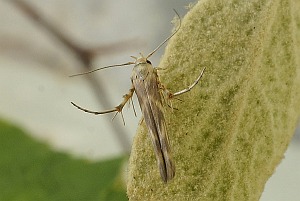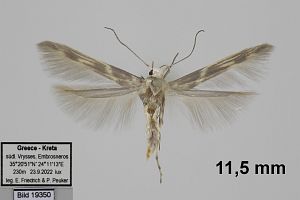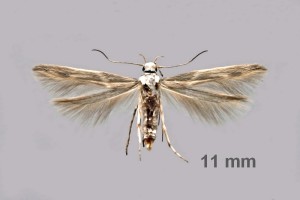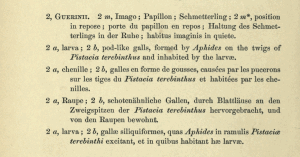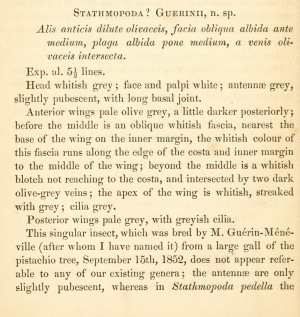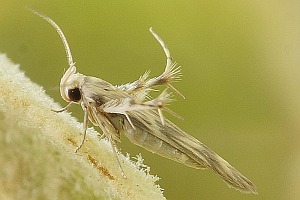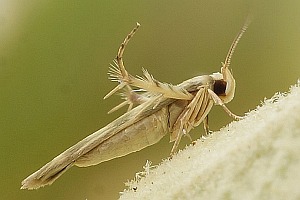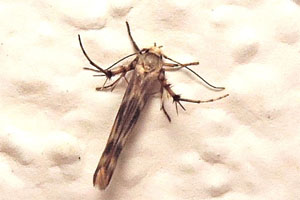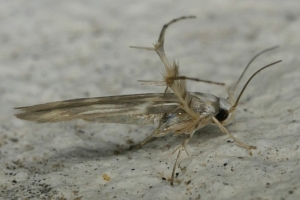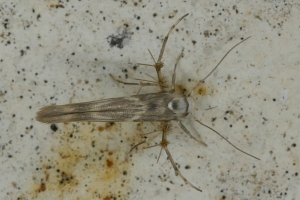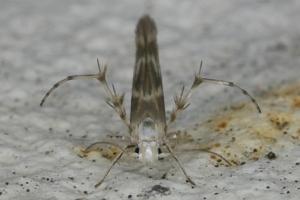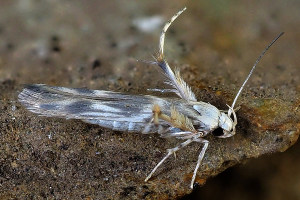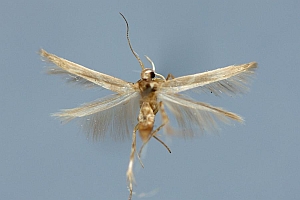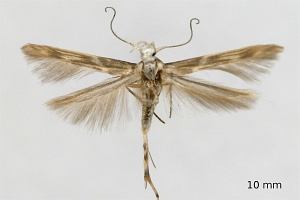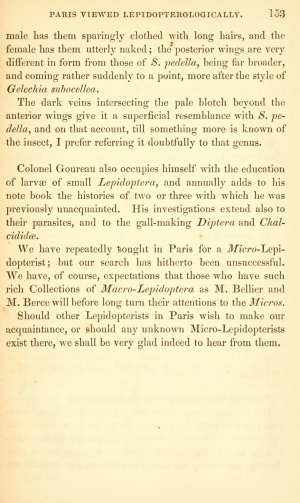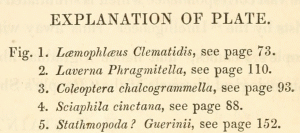1. Lebendfotos
1.1. Falter
2. Diagnose
2.1. Weibchen
2.2. Geschlecht nicht bestimmt
2.3. Raupe
2.4. Erstbeschreibung
3. Biologie
3.1. Nahrung der Raupe
- [Anacardiaceae:] Pistacia terebinthus ssp. palaestina (Terebinthe)
- [Anacardiaceae:] Pistacia atlantica (Atlantische Pistazie)
Bidzilya et al. (2019: 31-32) melden: "In Israel larvae feed on Pistacia terebinthus ssp. palaestina (Boiss.) Engl. and P. atlantica Desf. (Halperin 1986: 126, 128, 130, 131). They were also observed in galls of aphids (Hemiptera: Eriosomatidae, Fordinae) on Pistacia spp. and in galls of Tetraneura caerulescens (Passerini, 1856) (Hemiptera: Aphididae) on Ulmus sp. (Halperin & Sauter 1992: 134)."
4. Weitere Informationen
4.1. Etymologie (Namenserklärung)
Der Erstbeschreibung ist zu entnehmen, dass sie auf einem Exemplar beruht, das aus einer großen Galle (einer Gallmücke?) an einem Pistazien-Baum (= Pistacia vera) gezüchtet wurde. Ein Fundort wurde nicht genannt, aber der Züchter: "M. Guérin-Ménéville (after whom I have named it)". Es ist davon auszugehen, dass hier der französische Entomologe Félix Édouard Guérin-Méneville (1799–1874) gemeint war, der neben den Schmetterlingen Antheraea pernyi, Antheraea yamamai und Azanus jesous auch zahlreiche Insekten aus anderen Ordnungen beschrieben hat.
4.2. Andere Kombinationen
- Stathmopoda guerinii Stainton, 1858 [Originalkombination]
4.3. Synonyme
- Palumbina terebintella Rondani, 1876
- Tinea pistaciae Anagnostopoulos, 1935
4.4. Literatur
- Bidzilya, O., Karsholt, O., Kravchenko, V. & J. Šumpich (2019): An annotated checklist of Gelechiidae (Lepidoptera) of Israel with description of two new species. — Zootaxa, 4677 (1): 1-68.
- Erstbeschreibung: Stainton, H. T. (1858): Paris viewed lepidopterologically. — The Entomologist's Annual for MDCCCLVIII: 151-153 + pl. fig. 5. London (John van Voorst).
- Stainton, H. T. (1870): The natural history of the Tineina 12: [I-VII], 1-259, pl. I-VIII. London (John van Voorst) – Paris (Deyrolle) – Berlin (E. S. Mittler und Sohn). — Digitalisat auf archive.org: [58-67], [pl. II fig. 2].




![Vorkommen in Frankreich (europäisches Territorium ohne Korsika) [Vandromme et al. (2020): Liste systématique et taxinomique des Lépidoptères de France]](/res/img/flag/fr.gif)
![Vorkommen auf Korsika [Vandromme et al. (2020): Liste systématique et taxinomique des Lépidoptères de France]](/res/img/flag/fr-cor.png)
![Vorkommen in Monaco [Lemaire & Billi (2018)]](/res/img/flag/mc.gif)
![Vorkommen in Spanien (Festland) [Vives Moreno A. (2014)]](/res/img/flag/es.gif)
![Vorkommen auf den Kanarischen Inseln [Vives Moreno, A. (2014)]](/res/img/flag/es-cn.png)
![Vorkommen auf den Balearischen Inseln (Spanien) [z.B. https://www.inaturalist.org/observations/154948119]](/res/img/flag/es-ib.gif)
![Vorkommen in Portugal (Festland) [Corley (2015): Lepidoptera of Continental Portugal]](/res/img/flag/pt.gif)
![Vorkommen in Italien (Festland und kleine festlandsnahe Inseln) [Baldizzone et al. (1995): Checklist delle Specie della Fauna Italiana 83]](/res/img/flag/it.gif)

![Vorkommen in Sizilien [Baldizzone et al. (1995): Checklist delle Specie della Fauna Italiana 83]](/res/img/flag/it-sic.png)
![Vorkommen in Malta [Sammut (1984)]](/res/img/flag/mt.gif)
![Vorkommen in Slowenien [Deutsch H. (2019): Contribution to the Lepidopteran fauna of Slovenia]](/res/img/flag/si.gif)
![Vorkommen in Kroatien [Karsholt, Baldizzone & Gomboc (2023)]](/res/img/flag/hr.gif)
![Vorkommen in Montenegro [https://www.inaturalist.org/observations/149028504]](/res/img/flag/me.gif)
![Vorkommen in Griechenland (Festland und festlandsnahe Inseln) [Gozmany (2012): The Lepidoptera of Greece and Cyprus Volume I]](/res/img/flag/gr.png)
![Vorkommen auf Kreta [Gozmany (2012): The Lepidoptera of Greece and Cyprus Volume I. Foto im Forum]](/res/img/flag/gr.gif)
![Vorkommen auf Zypern [Gozmany (2012): The Lepidoptera of Greece and Cyprus Volume I]](/res/img/flag/cy.gif)
![Vorkommen im asiatischen Teil der Türkei [inaturlist.org]](/res/img/flag/tr.gif)
![Vorkommen in Israel [Bidzilya, Karsholt, Kravchenko & Šumpich (2019)]](/res/img/flag/il.gif)
